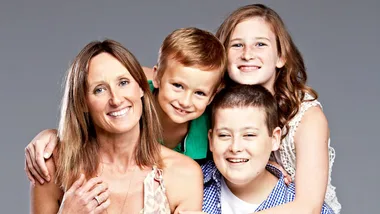Charlene Ebbs first noticed something was wrong with her daughter, Kalani, when she was four months-old.
“Every time I picked Kalani up, her head would tilt to the left side, but when she was laying down, her head would straighten back up again. Because I had two older children who were ahead of their milestones, by that four months I started to question why Kalani’s head and neck control was still quite floppy and at the newborn stage.”
After speaking to her physiotherapist sister, the 31 year-old mum booked the next available appointment with Kalani’s paediatrician, but as it was the Christmas break, they had to wait around six weeks.
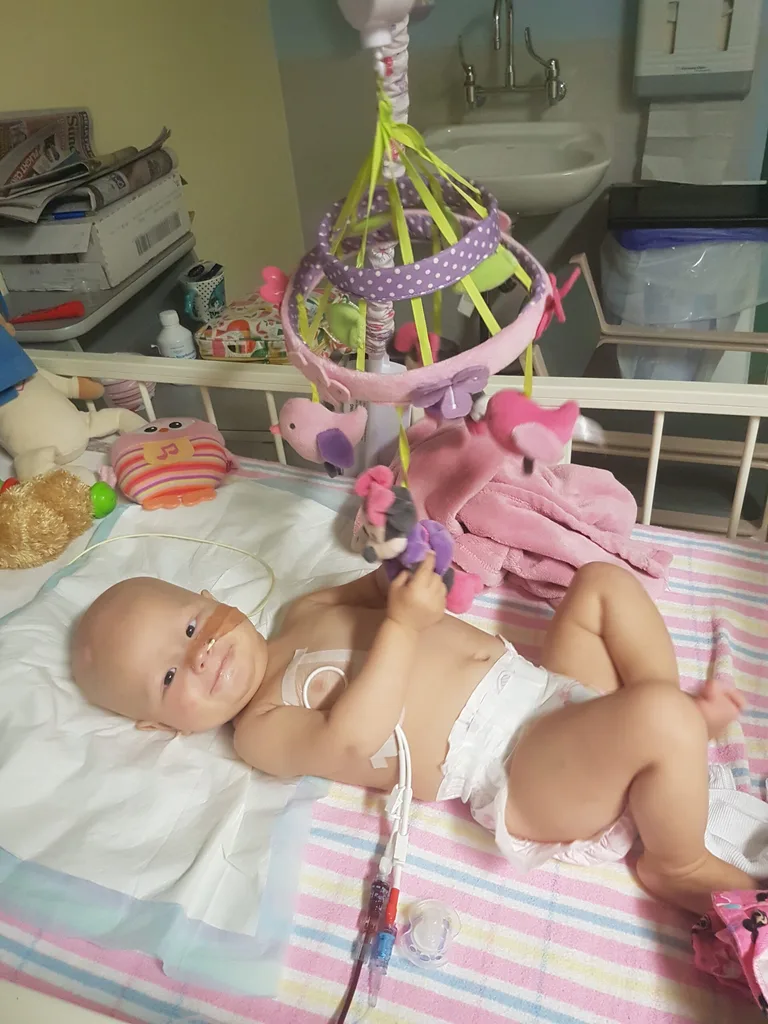
The first sign something was wrong was when Charlene noticed Kalani’s lack of head and neck control.
“During those six weeks, Kalani’s head started to straighten back up again but she suddenly started vomiting one vomit a day every day for one week, then two vomits a day every day for the second week and so the gradual vomiting escalated until she couldn’t keep any of her food down.”
Kalani’s paediatrician assumed that she was suffering from reflux, but when the vomiting continued even after she had been given medication, Charlene grew more concerned.
“At her paediatric physio appointment, the physio noticed that every time I’d feed her the bottle, she’d vomit it back up. She was vomiting anything and everything. Even when her stomach was completely empty, she would literally vomit up the acid from her stomach and bile and it was quite harrowing to watch her really struggle and see the pain that she was in.”
Since they were already at Wollongong Hospital, the physio immediately walked out to emergency with Charlene and admitted Kalani in.
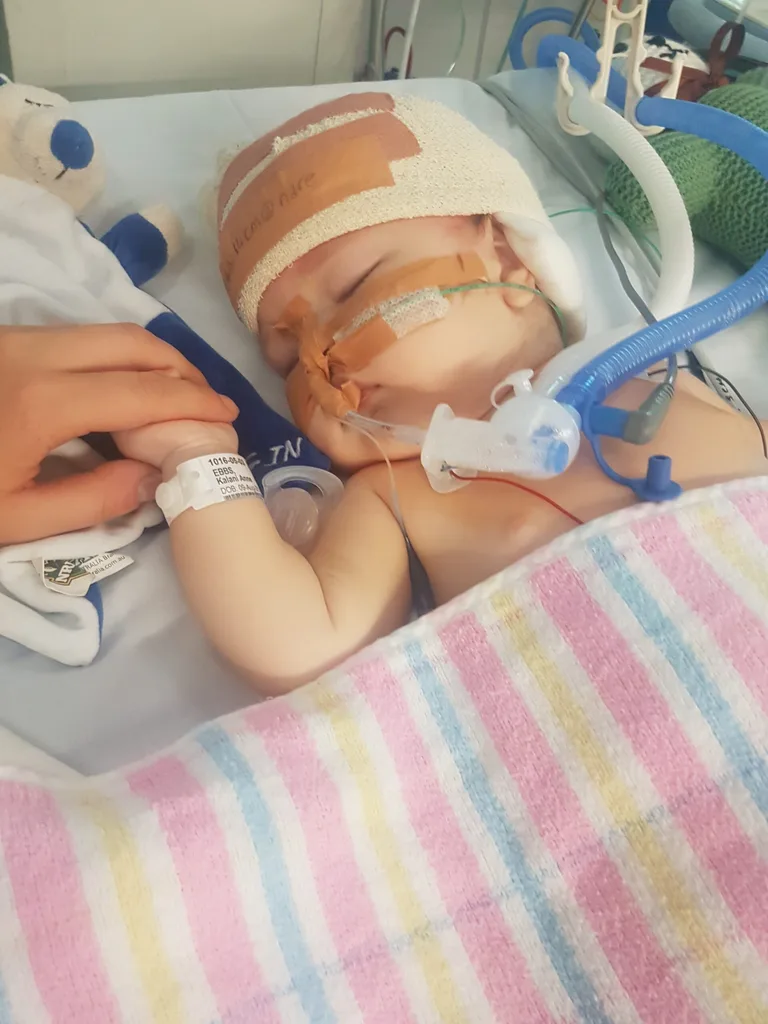
What doctors initially thought was reflux turned out to be much more serious.
Kalani was tested for a potential gastro virus that could have interfered with her Losec medication, but when her blood work came back saying there were no issues, a light flicked on in the paediatrician’s mind to check neurologically.
After three days in hospital, an ultrasound was ordered for Kalani’s brain that showed she had severe hydrocephalus – a build-up of Cerebrospinal Fluid (CSF) in her brain and that all four ventricles in her brain were severely enlarged.
“We tried to remain positive, we thought worst case scenario was Kalani has hydrocephalus, she’d have a shunt put in, they’d drain the fluid and that would be the worst of our worries. But I had this fear inside of me that something else was going on and I ended up quickly packing our bags.”
On the fourth day, the paediatrician ordered an MRI to confirm the ultrasound’s findings on Kalani’s brain.
“That evening, at 7pm on day four, our paediatrician was pacing the hallway outside our hospital room. I had this gut-wrenching feeling that something was really terribly wrong and I was starting to panic.”

“We’re all aware of brain tumours, but the fact that a six-month old could have that was a huge realisation for us and I guess at that stage we weren’t aware.”
When the paediatrician took Charlene, her husband, Justin, and her sister into a private room to inform them that Kalani had a brain tumour, they were in shock.
“We were speechless, so overwhelmed because medically, we were just not prepared for this and we had no idea of what we were heading into. We’re all aware of brain tumours, but the fact that a six-month old could have that was a huge realisation for us and I guess at that stage we weren’t aware.”
The family barely had a moment to process the news as teams immediately started to prepare to transport Kalani to Sydney for emergency brain surgery the next morning.
“The poor nurse at Wollongong Hospital that went through the transportation with me had to deal with me crying and asking all these questions that she couldn’t answer. By that stage we’d spent four days in hospital, and the news was getting worse every time they were delivering news to us so we were so exhausted and literally freaking out as we had no idea what was going on. We were completely unprepared and being thrown deep into the unknown.”

For the first three months of Kalani’s treatment, it was just the two of them.
The first three months were quite isolating for Charlene as she and Kalani were based at Sydney Children’s Hospital and Ronald McDonald House for a gruelling 51 week process of chemotherapy, while her husband and two older children stayed at home.
“In a way we were sort of lucky as Kalani won’t have a great deal of memory of what happened to her because she was so young. At that young age, that’s the time when parents really shower their children with so much love and affection and just embrace their childhood and for me, just hearing her cry and seeing her pain all the time and seeing this child who should’ve been having the best first few years of her life and of her development, I felt like I was torn in two.”
“I was being told the information of her treatment and how it would damage and hurt her and traumatise her, and as a mother, you don’t want to put your child through that, but I was also the reason that’s allowed them to deliver that treatment and put her through that because I wanted her to live, so it was a very ironic situation that we were in.”
Charlene and her husband aimed to keep life as normal as possible for her two eldest children, Kallen and Khaleesi, to try and maintain somewhat of a routine for their mental wellbeing.
“Kallen was only five years old at the time of the diagnosis and Khaleesi was two, so Khaleesi spent her second birthday in hospital with us two days after Kalani’s surgery.”
“My son’s always been very attached to me so I think it affected him the most, not having me at home for the first three months of Kalani’s treatment, and he also started kindergarten that year so that was a stressful time for him.”
“My two-year old is quite resilient but every time I came home, I noticed she would start to cling on to me as well, and although she doesn’t know the whole story, she understands that Kalani’s unwell.”
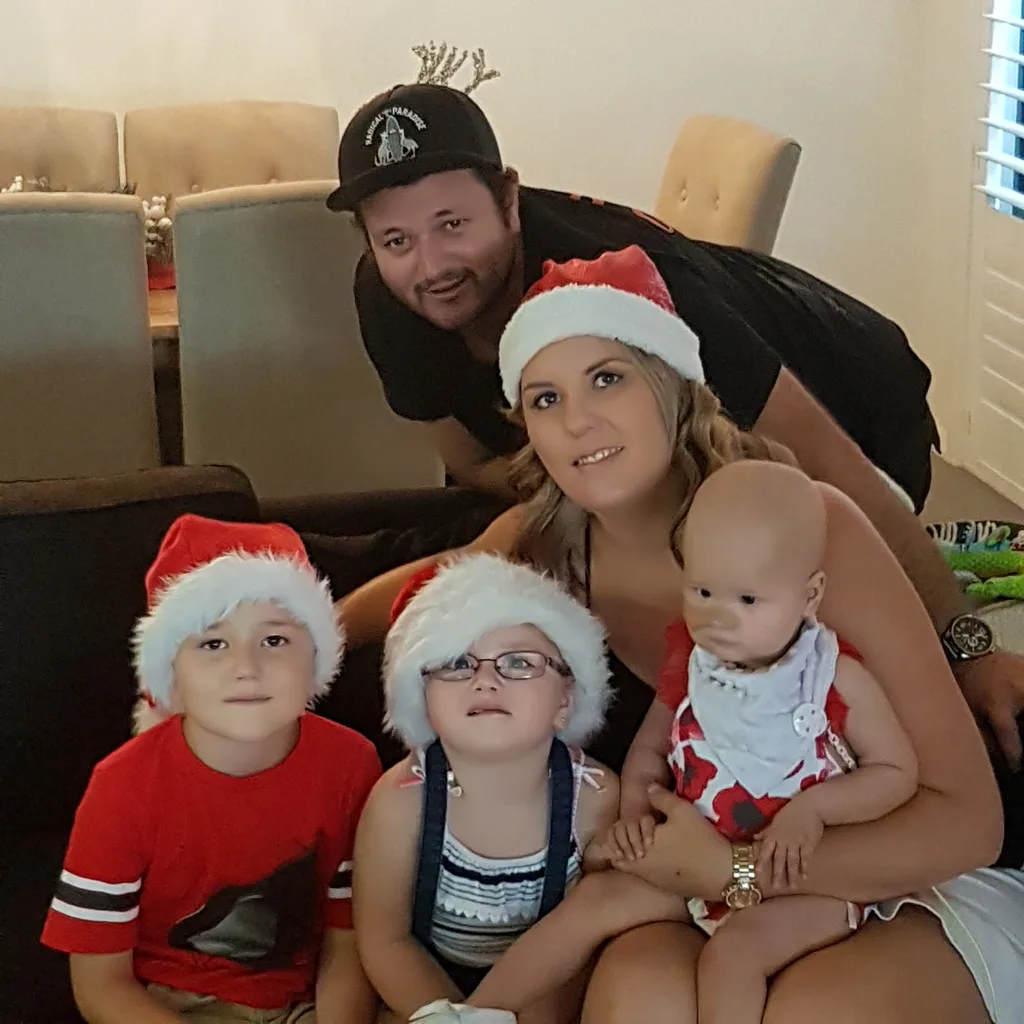
Justin and Charlene Ebbs with their three children, Kallen, Khaleesi and Kalani.
To avoid spending an entire 15 months in hospital and enable the family to be together more often, Charlene had to act like Kalani’s nurse at home.
“I had to train myself to deliver her meds through her NG tube, to work her feeding tube and deliver her feed, to give her injections in her legs 24 hours post-treatment, changing the tape on her face, her NG tube, because otherwise that would mean continuously driving back and forth to the hospital.”
Kalani’s final chemotherapy treatment was in May 2018 and has been in remission since then, but due to the intensive chemotherapy and radiation treatments, there will be obstacles in her future including her physical coordination, learning difficulties and infertility. However, brave Kalani is a fighter and her parents are grateful to the medical professionals that are the reason she’s still here.
“My paediatrician saved Kalani’s life. If he had waited a day, a week or even a month, Kalani could have started going through seizures or she could have haemorrhaged through the brain.”
“We were so lucky that we had such an amazing neurosurgeon as well because not many neurosurgeons are confident enough to operate on a six-month old and ours stepped up and she’s one of the best in the industry and mobilised her team in a matter of hours. Kalani came out best case scenario. “
“Kalani’s strength is inspiring, she melts the heart of everyone she meets through her radiant smile. Her smile never stopped even once during the course of her treatment. Kalani is my hero!”
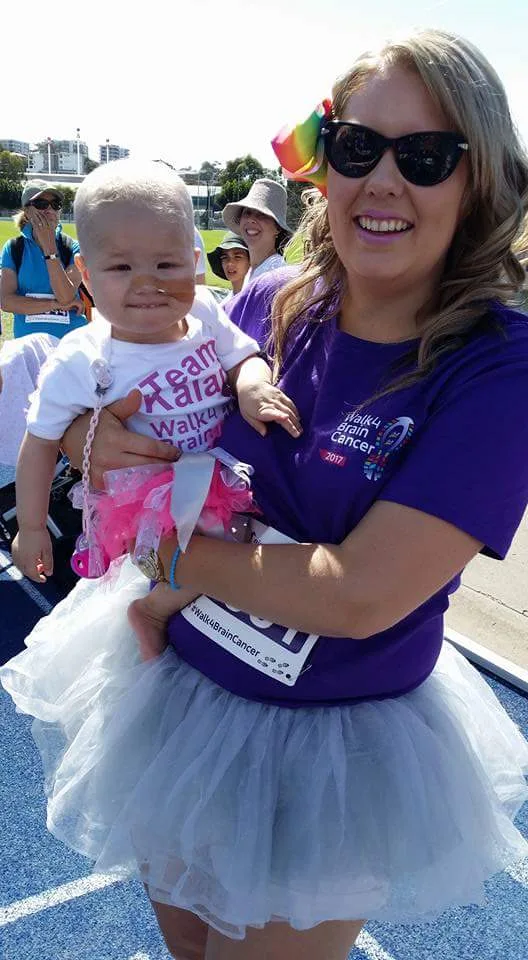
Charlene and Kalani on the Walk 4 Brain Cancer in Wollongong, NSW.
Charlene is now studying law and is passionate about helping other families in similar situations.
“The brain cancer community is very quiet about what they are going through. I know it’s really hard for other families to have someone going through brain cancer to speak out about it because of all the trauma and the suffering. I hope that more families can talk about their experiences and their journeys so that it can get the Australian people behind this cause and to work together as a nation to try and find a cure.
“My future goal is to complete my law degree and help the foundations liaise with the government and overseas and fight for trials to be brought to Australia. I want to be a part of and continue to advocate for change in brain cancer research in whatever way I can be and help other families going through the same journey we did.”
For more information about the Cure Brain Cancer Foundation, visit their website here.
The Cure Brain Cancer Foundation is also holding their annual Gala Ball in Sydney in September to raise much-needed funds to find a cure. If you want to eat good food, check out some haute couture fashion and rub shoulders with celebrities including Home and Away‘s Johnny Ruffo, grab trickets here.
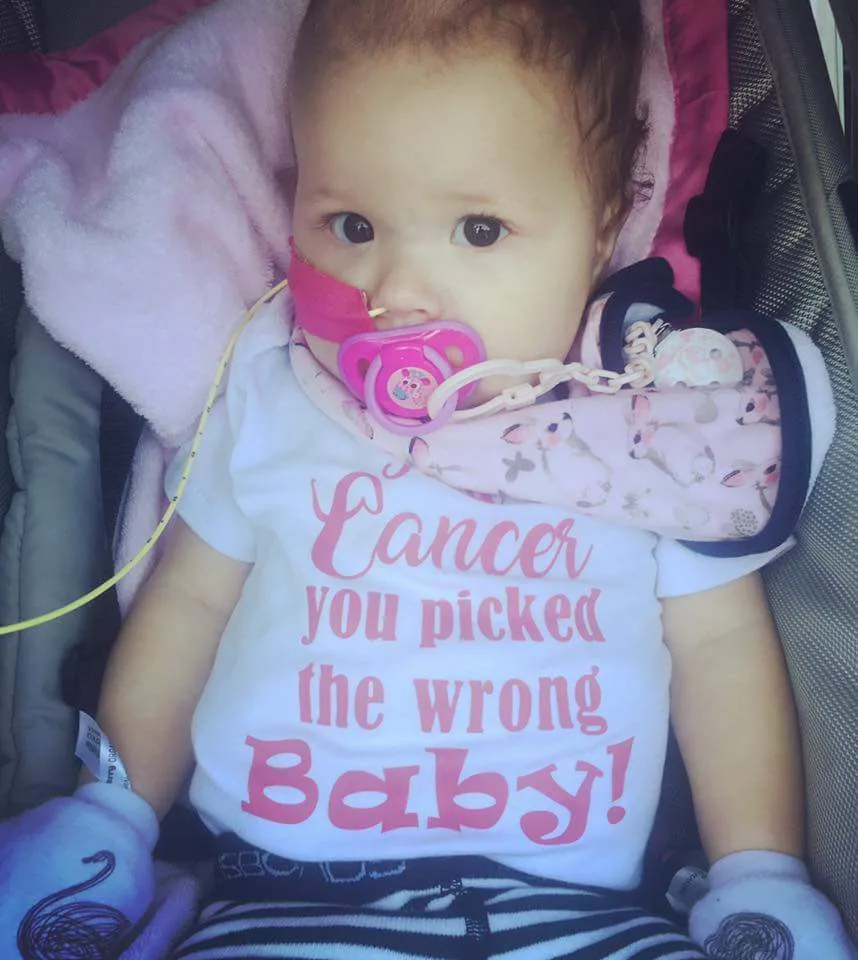
Brave Kalani’s strength is truly inspiring.


